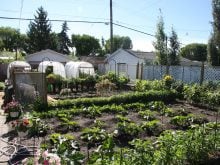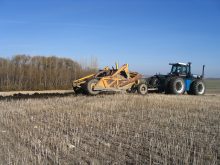Questions are being asked with the rise of research and product releases for microbiological tools in agriculture
A significant hurdle that manufacturers of microbial-based cropping products must overcome is of their own making.
“We’ve created our own problem by overpromising what biologicals are capable of doing, and so we’re living with that right now and it’s a bit of an inflection point where we’re trying to change that image, be it with farmers, be it with partners or with regulators,” said Jason Garbell of Novozymes, the world’s largest industrial biotechnology company.
He said there are a few high performing microbial-based products available to farmers, but the industry is just starting to get it established.
Read Also

Fertilizer method’s link to emissions studied
A researcher says others studying greenhouse gas emissions aren’t considering how the loss of nitrogen into the atmosphere correlates with fertilizer application or if there is an impact to yield.
“By the end of the decade, I think we’re going to start to see a lot of really good technology.
“I think people have learned that what we thought was going to work, and what we oversold wasn’t the way, and now we’ve learned from our mistakes and we’re digging in with harder science,” Garbell said during a panel discussion at World Agri-Tech Innovation Summit 2022, that was held in San Francisco, California, and online.
Anthony Finbow, chief executive officer of Eagle Genomics, said he focuses on building the tech stack to enable microbiome science and exploration, and that the industry still tends to look at individual micro-organisms and small consortium of microbes.
However, technology is beginning to allow for a more holistic approach.
“The genetic content, the information content in a microbial consortium acting in concert with the host organism, be that a plant, animal, or a human and figuring out using network science how this interaction, how this conversation between a microbial ecology and a host is breaking down or how we’re enhancing it. I think this is the disruptive opportunity we have,” Finbow said.
He said to help companies come to market faster with evidence that supports product claims, his company is networking microbiome science.
“We’re building a network stack that takes learnings from the telecommunications network management industry to enable data centric collaboration between research establishments and enterprises,” Finbow said.
He said it’s important to think of the micro-organisms as a process instead of individual objects.
For instance, the human genomics industry can look at a cell with a nucleus that has energy-generation mechanisms that enable it to conserve its genome.
But a microbe might replicate 50 to 300 times a day.
“In a constrained environment it sheds genetic content. In an abundant environment it, through a range of mechanisms, bacteria conjugation, access to extra cellular genomic threads in the soil, it will accrue genetic content. So, how do you solve that?” Finbow said.
“There’s only one approach that’s going to enable that, that’s true network science through the ecology understanding, the ecology of microbes interacting in a system. So, I see a huge opportunity there.”
He said with data networked, users can aggregate understanding of individual microbes and microbes acting in concert in an ecology, then causal inference algorithms can be applied to data to generate hypotheses that can be tested.
Jamie Bacher, chief executive officer of Boost Biomes, said the industry has struggled with understanding the soil data it has collected and it needs to think more holistically rather than in a reductionist way.
“Over the last 20-30 plus years we’ve been thinking in terms of microbes as single products that are going to go into the soil and… that one microbe is going to be the silver bullet,” Bacher said.
“We can think a lot more now about microbial ecology and we can think about what are the relationships between the microbes that are already in the soil, and the plant, and whatever the product has to accomplish.”
He said a focus of advanced biological-based product research is to understand how to assemble microbes that can work together with micro-organisms in the environment.
“How can we assemble microbes that are not going to be beaten up as soon as they go into this new environment, or whatever soil environment they’re going to go into. We’re thinking a lot about how we can set up products for success when they’re in the wild without being overly reductionist or overly simplistic, and really giving an opportunity for new products to come to market that way.”
Don Maszle, technical solutions consultant at Benchling, said he sees the microbial-based product industry moving where much of agriculture has already moved — “heavy on the data and technological development.”
He said new technologies are being developed in the biologicals sphere and finding a way to integrate data will be a challenge.
“In the last 10 years, as biostimulants have become such a phenomenon, how many genomes have we sequenced within that realm that we had no knowledge of 10 years ago, and how has that accelerated the discoveries? Multifold really,” Maszle said.
One of the overpromises manufactures of biological-based products have made is that products will be able to replace synthetic-based crop protection products and fertilizer.
However, Garbell said the industry will be forced to create products that work in conjunction with synthetic products for the foreseeable future.
“The dream or the overpromise that these things are going to replace some chemistries is, for many of the cases, not the case,” Garbell said.
Mike Miille, chief executive officer of Joyn Bio, said there are examples where microbial biologicals work well with synthetic products.
“If you look at seed treatments that are out there on a lot of corn crops and different seeds, there are combinations of chemicals and microbials to achieve that effect that you want, and they have to be compatible,” Miille said.
“Another major use is around trying to achieve specific (maximum residue levels), where so you have a program, and you might have three chemical sprays and you might have three microbial sprays and the result is a much lower residue level than if you use all chemical.”
He said to get new products in farmers hands more quickly, the industry must change how products are brought to market.
“How do you go from 10 or 12 years, to two to three to four without sacrificing safety?” Miille said.
“It’s not just regulatory that adds up to that 10 or 12 years, the whole process from start to finish has to be looked at — regulatory is a part of it, but there’s other pieces as well. I think it’s a huge challenge for the whole industry to really get their head around.”
When it comes to the safety aspect of introducing novel genetic sequences into natural microbiomes, especially given the irreversibility of environmental release, Miille said a responsible company must look at how products persist in an environment by using sequencing.
“Companies are finally looking at that whole plant microbiome in a holistic way. So, the technologies there… I don’t think any of us today could say absolutely this can’t happen or this will happen, but we have an obligation to use the technology to provide the safety data before you ever put the product out there,” Miille said.
Bacher said the safety data companies accrue will not necessarily provide complete answers.
“When you’re talking about genetic exchange in the soil, it’s going to happen. The question is what is a safety threshold that we at a societal level are happy with,” Bacher said.
Finbow said about one percent of the microbial content of the soil has been characterized thus far.


















